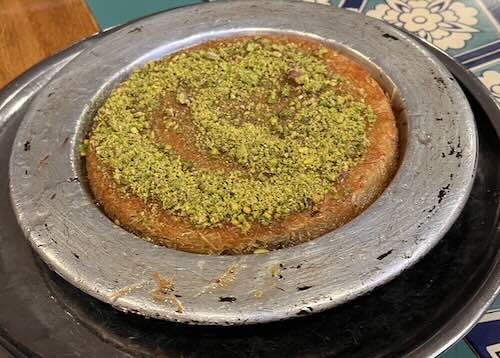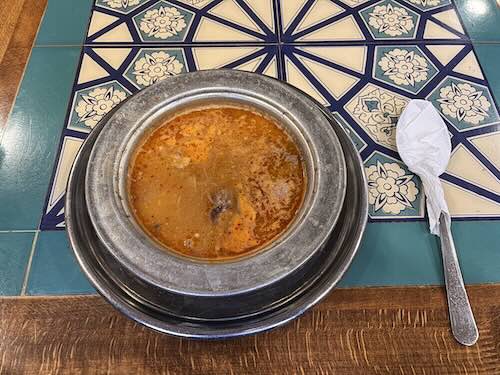Best Way to Spend A Day in Istanbul: Food Tour Recommendation
Do you love food and exploring local culture? A local food tour is one of the best ways you can spend a day in Istanbul.
If you’re looking for a highly recommended Istanbul food tour, the following review will show you why we love Culinary Backstreets and help you decide if their tours are right for you.
About Culinary Backstreets
Although our first experience with Culinary Backstreets was in Lisbon, the organization was actually started in Istanbul. Founded by journalists, they are passionate about telling the stories behind a city’s foodways.
Culinary Backstreets promotes and protects traditional culinary culture, highlighting masters of their craft and family-run establishments through walking tours, downloadable Eatineraries, and written articles.
You’ll also find them in popular foodie destinations like Athens, Barcelona, Naples, Tbilisi, Queens, Mexico City, Rio, Tokyo, and Shanghai.
“We use food as a lens through which we explore urban issues, highlighting lesser-told stories and people, revealing a deeper side of the city. I think you’ll really enjoy what we have created.”
– Ansel Mullins, Co-Founder of Culinary Backstreets
Culinary Backstreets Istanbul Tours
At the time of this writing, there are seven different food experiences in Istanbul: four culinary tours that depart in the morning and run for roughly 5 hours, one evening tour, and a hands-on market/cooking experience that can be done in the morning or evening.
Each tour focuses on different neighborhoods throughout the city. A couple of the tours include crossing the Bosphorus River by ferry.
We got to do a complimentary Culinary Secrets of the Old City tour during our short stopover in Istanbul, in exchange for an honest review here on the blog. (As always, the opinions expressed in our reviews are entirely our own.)
Our guide, Uğur, was a native of Istanbul who has been leading tours with Culinary Backstreets for about a decade. As it happens, he actually studied abroad in our home state of Oregon!
We met Uğur at 9:30 a.m. and were joined by three others for an enjoyable day walking and eating off-the-beaten-path in Istanbul’s Old City.
Culinary Secrets of Old City Tour Details:
Distance: We walked less than 2 miles. Of course, this was broken up into short bits throughout the day.
Time: 5 hours
Food: All-inclusive price covers breakfast, snacks, samples, coffee, lunch, desserts, etc. It is a fairly meat-heavy itinerary and no alcohol is served. Gluten-free or vegetarian alternatives are not always possible.
Who it’s for: Independent travelers looking to eat well and learn about the food culture of Istanbul. This tour is more of a deep dive into a series of neighborhoods than an overview of the city’s whole history.
Participants should come hungry and curious!
We really loved that this tour stayed mostly outside of Istanbul’s busy tourist areas, uncovering every-day culture and historic traditions, while sampling local favorites. It showed us a side of Istanbul we would not have discovered on our own and allowed us to try all kinds of new dishes.
Istanbul Food Tour Stops
We started the tour in the Eminonu area on the European side of the city, which is conveniently located near both a tram line and ferry terminal.
From the meeting point, we set out to explore the spice market and Egyptian bazaar.
Uğur pointed out the products that locals commonly shop for at the market, such as olives, “white” (feta) cheese, all things pickled, and tomato pastes, all displayed in colorful patterns.
Suddenly, we were in a quiet corner of a building where a table had been set for our Turkish breakfast! The impressive spread included two cheeses, wild thyme cooked in oil and salt, pastrami, tomato paste, green and black olives, a rose dip, tahini with grape molasses (a.k.a. Turkish nutella), honey, buffalo clotted cream, buttery brioche with cheese, typical simit (Turkish bagels) with sesame seeds…
We were wisely warned to pace ourselves and go light on the bread, as large quantities of bread would be a recurring theme at many of our upcoming stops.
Through this initial breakfast, we dove into the food culture and history as Uğur answered our questions about how meals are typically served and shared unique traditions around Turkish coffee and tea.
He was both informative and fun, always with a smile on his face and happy to share his native culture.
Meanwhile, we were fascinated to witness the tea delivery service next to us, exclusively serving vendors within the market. They operated out of a closet-size shop with a pulley system to quickly deliver hot drinks up and down the multi-story stairwell.
After breakfast, we explored further into the Egyptian Bazaar, a covered market with roughly 100 shops (compared to 4000 shops in the overwhelming Grand Bazaar across town).
Vendors were selling everything from prayer beads to cheese and spices, from tea for every ailment to gold jewelry and coins for wedding ceremonies.
Before we knew it, it was time for our next food stop: a Beyran soup restaurant. This savory soup is cooked to order, featuring meat, garlic, vinegar, and rice along with your preferred amount of chili.
Although sans-chili is not typical, I was delighted to have my non-spicy soup, which was still incredibly tasty.
The soup was followed by a Middle Eastern dessert made of thin dough with cheese, cooked on a grill and topped with pistachios.
Next, we visited a nearby mosque, one even older than the famous Blue Mosque with elaborate decorative tiles outside and the ornate door pictured below.
Although Turkiye is a secular country, a large portion of the population follow Sunni Islam, so mosques and the call to prayer play a prominent role in city life, and it’s helpful as a traveler to understand more about these traditions.
Soon, we sat down at a simple place that specializes in kofte (meatballs) made of lamb and beef. Hot sauce was on the side with a vegetable salad.
From there we proceeded to a candy shop that’s been in business for six generations. We sampled rock candies, Turkish delight of various flavors, candy made with apricot seeds and others with a tahini base, while learning about some of the history behind the treats and their names.
As we ventured into corners of the Old City beyond where tourists usually go, hidden in a courtyard, we encountered a pair of brother copper smiths who make and repair the giant copper bowls used by the area’s local confectioners.
Then we stopped for fresh-squeezed pomegranate juice, mixed with a bit of fresh orange. It was delightfully refreshing.
Next up was a well-known Turkish classic, except with a twist: döner stacked with layers of tomato and green pepper.
By this time, we were already pretty full so, fortunately, the döner sandwich was sample-size. Nevertheless, there was even more filling food around the corner!
Sitting down at a restaurant bustling with locals of every age, we were served three different types of pide to sample. Pide is similar to flat bread pizza, usually topped with different types of meat and cheese. We also tried roasted green peppers and ayran – a salty, yogurt-based drink.
One of my favorite stops was a family-run cafe serving just one thing since 1876: boza, a thick drink made from millet, water and sugar.
Slightly fermented and topped with cinnamon, it gave the flavor of applesauce yet creamier. Everyone in our group enjoyed it, though it’s not always a hit among American visitors.
We ended our tour on another side of the Fatıh neighborhood, visiting another mosque, Roman aqueduct, and market area predominantly from Southeastern Turkey.
Here, we sat for a final meal featuring lamb, after seeing the pit in the floor of the kitchen where it gets cooked. Ribs, bread, salad with olive oil and pomegranate molasses, “curtain” pilav (a pie-like rice dish), and desserts of rice custard and pumpkin with tahini topped us off.
Needless to say, our bellies were very full after 5 hours of eating so we had no need for dinner.
All in all, we had a great time with the guide and our fellow travelers, which left us inspired to see more, learn more, and come back for more food throughout Turkey.
>> Use discount code INTLTRVL for 5% off any Culinary Backstreets tour <<
Final Thoughts about Culinary Backstreets
We have been very impressed by Culinary Backstreets from start to finish.
Their communications were very helpful and thorough, their local guides are experts in their subject matter, and their mission aligns perfectly with intentional travel. Their pricing may be higher than others, but we think you will be hard-pressed to find a higher quality, curated cultural experience.
We came away from the tour with deeper insight into a side of Istanbul we never would have experienced otherwise.
The food itself was all excellent and the tour included a number of new things we got to try for the first time. We felt bad that we were leaving some things uneaten by the end, but we left so full that we didn’t bother eating anything for dinner later!
All in all, it was a great tour. If you’re looking for an off-the-beaten-path cultural experience, we would recommend checking out Culinary Backstreets. Don’t forget to use discount code INTLTRVL for 5% off any Culinary Backstreets tour!
Read more about Culinary Backstreets tours here:
Lisbon Food Tour Review
Porto Portugal Food Tour Review
Like this post? Pin it for later or share with friends!

























